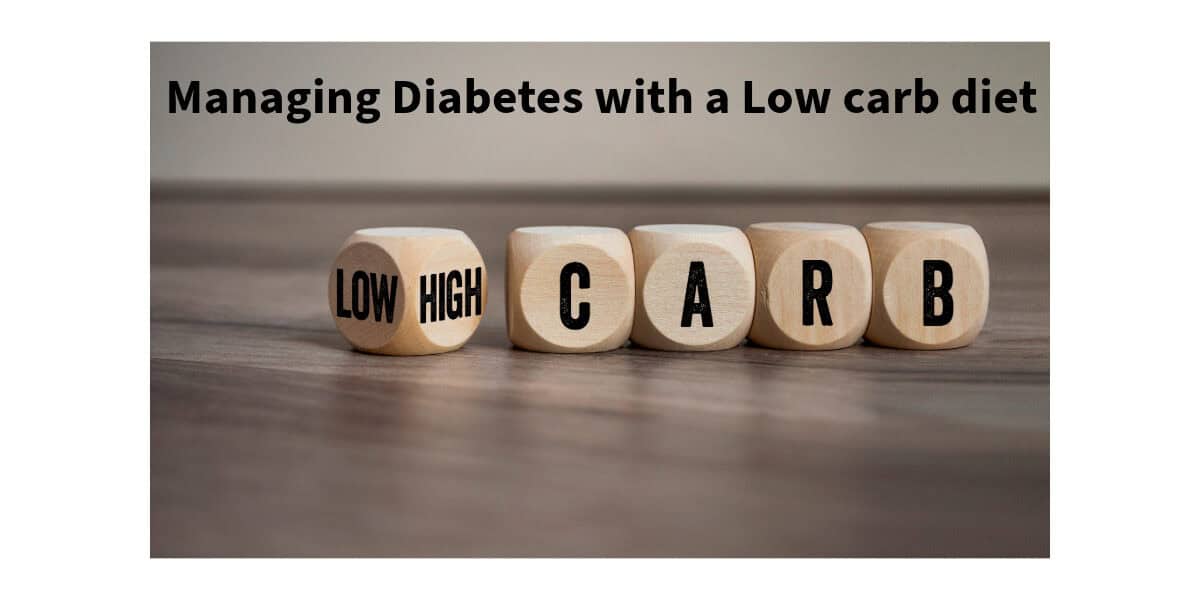Managing diabetes with a low-carb diet has become increasingly popular among people looking to manage diabetes. By reducing carbohydrate intake, this approach helps stabilize blood sugar levels, improve insulin sensitivity, and even promote weight loss—all key factors for managing diabetes effectively. This guide will explain how a low-carb diet can support diabetes management, provide meal ideas, and highlight potential pitfalls to watch out for.
How a Low-Carb Diet Helps Manage Diabetes
- Blood Sugar Control: Carbohydrates are quickly converted to glucose in the bloodstream, causing blood sugar spikes. By reducing carbs, you limit these fluctuations, making it easier to keep blood sugar levels in the target range.
- Improved Insulin Sensitivity: For people with Type 2 diabetes, insulin resistance is a common issue. Lowering carb intake can help reduce insulin spikes, potentially improving insulin sensitivity over time.
- Weight Management: A low-carb diet often includes high-protein and healthy-fat foods, which promote satiety. Feeling fuller for longer can aid in weight management, another essential aspect of diabetes control.
Low-Carb Diet for Diabetes: What to Eat
Focus on nutrient-rich, low-carb foods that will not spike your blood sugar levels. Here are some key categories and examples:
- Vegetables: Leafy greens (spinach, kale, arugula), broccoli, cauliflower, zucchini, and bell peppers.
- Proteins: Chicken, turkey, lean cuts of beef, salmon, tuna, and eggs.
- Healthy Fats: Avocado, olive oil, nuts, seeds, and full-fat Greek yogurt.
- Low-Glycemic Fruits: Berries (strawberries, blueberries, raspberries), which are lower in carbs compared to other fruits.
- Whole Grains: If you include grains, consider low-glycemic options like quinoa or barley in small portions.
Diabetes Low-Carb Meal Plan Ideas
- Breakfast: Scrambled eggs with spinach and a side of avocado. Add a sprinkle of cheese or nuts for extra flavor and healthy fats.
- Lunch: Grilled chicken breast served with a large salad made from leafy greens, cucumbers, bell peppers, and a dressing of olive oil and lemon juice.
- Snack: Greek yogurt with a handful of mixed berries or a handful of nuts like almonds or walnuts.
- Dinner: Baked salmon with a side of roasted broccoli and cauliflower. Season with herbs and spices like garlic and rosemary.
- Dessert (Optional): A small serving of chia pudding made with unsweetened almond milk and a few raspberries or blueberries for natural sweetness.
These meals are designed to keep carbohydrate levels low while providing essential nutrients that are diabetes-friendly.
Potential Pitfalls of a Low-Carb Diet for Diabetes
While a low-carb diet can be effective, there are some potential drawbacks:
- Nutritional Imbalance: Cutting too many carbs can lead to a deficiency in essential nutrients, such as fiber, vitamins, and minerals. Including a variety of vegetables, nuts, seeds, and low-carb fruits can help address this.
- Ketosis Risks: If carbohydrate intake is too low, the body may enter a state of ketosis. While ketosis isn’t inherently dangerous, it may not be suitable for everyone, especially people with Type 1 diabetes, due to the risk of diabetic ketoacidosis.
- Difficulty Adhering to the Diet: A low-carb diet can be challenging to maintain long-term. Finding satisfying low-carb alternatives and allowing some flexibility can improve adherence and overall satisfaction.
Final Thoughts on How to Manage Diabetes with a Low-Carb Diet
A low-carb diet offers a practical and effective approach to managing diabetes, especially for those looking to reduce blood sugar fluctuations, improve insulin sensitivity, and maintain a healthy weight. Embrace a balanced meal plan that includes a variety of low-carb, nutrient-rich foods to prevent potential nutritional deficiencies. Remember to consult with your healthcare provider or a registered dietitian to tailor your diet plan to your individual health needs and ensure it complements any diabetes medications or insulin therapies.
With a thoughtful, well-structured low-carb meal plan, you can achieve sustainable and positive results for your diabetes management journey.
FAQs: Managing Diabetes with a Low-Carb Diet
1. How many carbs should I eat per day on a low-carb diet for diabetes?
The exact amount can vary depending on individual needs, but a common range for a low-carb diet is 50-130 grams of carbohydrates per day. Consult with a healthcare provider to find the right balance for you, as individual carb tolerance can vary.
2. Can a low-carb diet help with both Type 1 and Type 2 diabetes?
Yes, though the effects can differ. For Type 2 diabetes, a low-carb diet may help improve insulin sensitivity and blood sugar control. For Type 1 diabetes, it can reduce blood sugar spikes, though it requires careful monitoring to avoid hypoglycemia. Always work with a healthcare professional when adjusting carb intake.
3. Will a low-carb diet cause low blood sugar levels?
It can, especially if you’re on diabetes medications that lower blood sugar. To prevent hypoglycemia, monitor your blood sugar regularly and adjust your diet and medications as needed with the guidance of your healthcare team.
4. What are some quick low-carb snack ideas for diabetics?
Good options include hard-boiled eggs, a handful of nuts, Greek yogurt with a few berries, sliced cucumber with hummus, or cheese sticks. These snacks are low in carbs and can help manage hunger without causing large blood sugar spikes.
5. Can I follow a low-carb diet if I have kidney disease?
If you have kidney disease, consult with your healthcare provider before starting a low-carb diet, as it may require adjustments to ensure your diet is safe and kidney-friendly.
6. Are low-carb diets the same as ketogenic diets?
Not necessarily. While both are low in carbs, a ketogenic (keto) diet is much stricter in terms of carbohydrate intake, usually allowing less than 50 grams of carbs per day to promote ketosis. A low-carb diet for diabetes may be less restrictive and does not necessarily aim to reach ketosis.
7. Can I eat fruit on a low-carb diet for diabetes?
Yes, but stick to low-glycemic fruits like berries (strawberries, blueberries, raspberries) in small portions. These fruits have less impact on blood sugar levels compared to higher-carb fruits like bananas or grapes.
8. What are the potential side effects of a low-carb diet?
Some people may experience fatigue, headaches, or digestive changes (like constipation) when first starting a low-carb diet. These effects usually subside as your body adjusts. To minimize them, drink plenty of water, eat fiber-rich vegetables, and include enough healthy fats.
9. How can I make sure I’m getting enough fiber on a low-carb diet?
Include low-carb, high-fiber vegetables like broccoli, cauliflower, leafy greens, and zucchini. Nuts, seeds, and berries are also good sources of fiber without significantly increasing carb intake.
10. Can I still eat bread on a low-carb diet for diabetes?
Yes, but look for low-carb bread options made from ingredients like almond or coconut flour. These options typically have a lower glycemic impact than traditional wheat-based bread.





